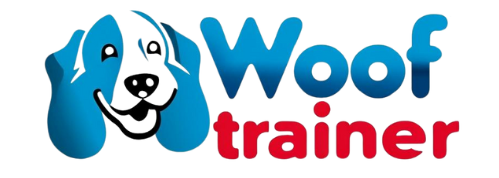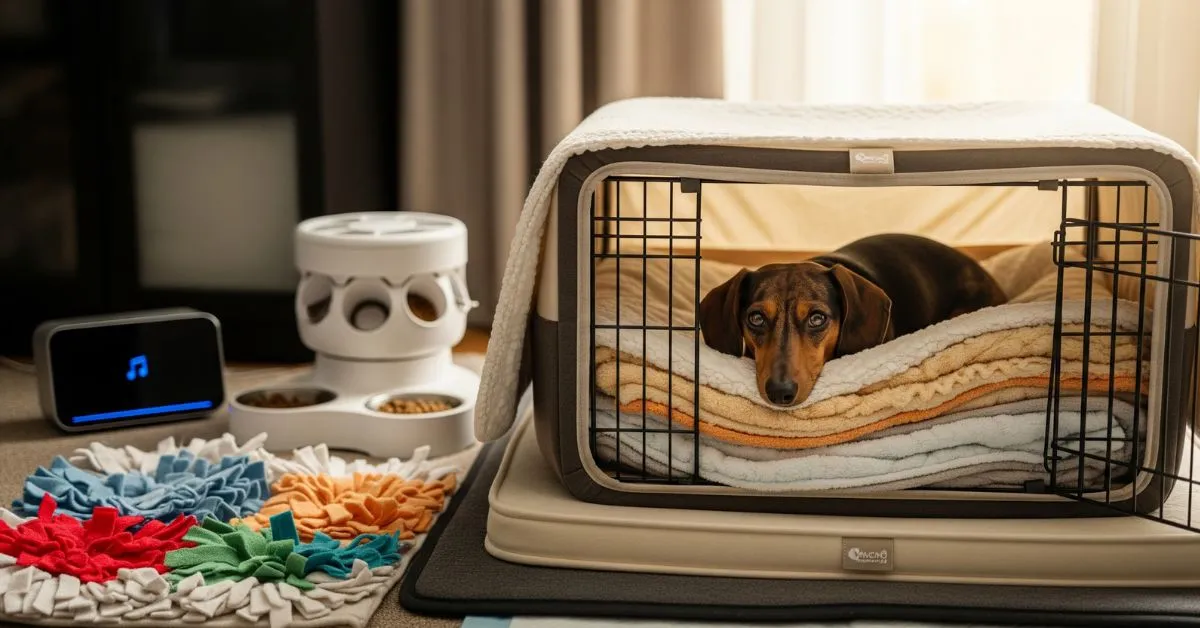Introduction
Are you going through this heart-wrenching experience?
Just yesterday, your dog was full of energy and joy. Today, even standing feels like a struggle. They look at you longingly, wanting to run toward you, but pain stops them in their tracks. For any dog parent, this sudden change is heartbreaking. You may even find yourself asking late at night:
“Am I being too cruel? Is it really okay to confine them in a crate?”
As a dog trainer with 12 years of experience who has worked alongside many veterinarians, I want you to know this: You are not a cruel jailer—you are your dog’s most steadfast protector. Strict crate rest is not punishment; it’s an “invisible cast” that helps your dog heal.
In this guide, you’ll get:
- A step-by-step IVDD recovery roadmap based on the latest research and clinical experience
- A practical care handbook (covering feeding, toileting, and more)
- Advice on how to use the right tools (like a swivel feeding system) to reduce risk and ease anxiety
- Emotional support tips to help you and your dog stay strong throughout the recovery journey
⚠️ Important Note: his guide is based on the combined experience of professional trainers and veterinary teams, referencing resources like Cornell University College of Veterinary Medicine and Dodgerslist. It does not replace your veterinarian’s diagnosis or prescription. Always follow your vet’s instructions.
Quick answer: Quick answer: In most cases, dogs with IVDD require at least 6–8 weeks of strict crate rest according to Dachshund IVDD UK’s conservative treatment guidelines , and dogs with neurological signs should receive a minimum of 8 weeks of strict rest.
Be patient—every effort you make today will determine whether your dog can one day run back to you with a wagging tail.
What Is IVDD, and Why Is Crate Rest the Gold Standard?
What Is IVDD?
Intervertebral Disc Disease (IVDD) is one of the most common spinal conditions in dogs. The discs between the vertebrae act like shock absorbers, made up of a tough outer ring and a gel-like center.
When a disc degenerates, ruptures, or bulges, the gel can press on the spinal cord, causing severe pain and sometimes paralysis.
High-risk breeds: Dachshunds, Corgis, Beagles, Basset Hounds, French Bulldogs and other chondrodystrophic breeds are particularly susceptible to IVDD according to Cornell University’s genetic risk overview.
Clinical Grading of IVDD
Veterinarians classify IVDD into five clinical grades according to the American College of Veterinary Surgeons:
| Grade | Clinical Signs | Treatment | Recovery Outlook |
|---|---|---|---|
| 1 | Mild pain, no neurological deficits | Conservative (crate rest + meds) | Very high (>90%) |
| 2 | Pain + mild incoordination | Conservative or surgery | High (80–90%) |
| 3 | Weakness or partial paralysis | Surgery preferred + crate rest | Moderate (60–80%) |
| 4 | Unable to walk, but pain present | Surgery required | Moderate (50–70%) |
| 5 | Complete paralysis, no pain sensation | Emergency surgery | Poor (<50%) |
Surgery vs. Conservative Treatment
Conservative treatment (crate rest)
- Best for: Grade 1–2, some Grade 3 cases
- Includes: Strict crate rest, pain/anti-inflammatory meds, physical therapy
- Success rate: Published data suggest 82–100% recovery in ambulatory dogs and 50–84% in non-ambulatory cases (Frankel grades 4–5) in prospective studies.
Surgical treatment
- Best for: Severe neurological impairment (Grade 3–5)
- Goal: Remove disc material compressing the spinal cord
- Success rate: Varies by grade—approximately 95% for Grade 3, 90% for Grade 4, and 50–60% for Grade 5 surgical cases.
Comparison: Surgery vs. Conservative Care
| Factor | Conservative Care | Surgery |
|---|---|---|
| Suitable Grades | 1–2 primarily | 3–5 |
| Success Rate | 85–95% (early) | 50–80% |
| Risks | Recurrence up to 66%, varying by grade (28–66%). | Anesthesia & surgical risks |
| Cost | Low–medium | High (thousands of dollars) |
| Recovery | 6–12 weeks | Typically 2–4 weeks for Grades 3–4; up to 2–12 months for Grade 5 cases. |
Why Crate Rest Is the Gold Standard
Think of crate rest as your dog’s cast. If they move freely, every jump or twist risks “reopening the wound,” preventing the disc from healing.
Research on disc healing phases (Dodgerslist) shows that scar tissue remodeling begins around 4–6 weeks post-injury and matures by 6–8 weeks. According to Dachshund IVDD UK’s conservative treatment guidelines, dogs adhering strictly to crate rest achieve up to 95% recovery in Grade 1–3 cases. Premature activity greatly increases reinjury risk, with recurrence rates up to 66%.
In other words: Strictness is the kindest form of care.
Creating a Healing Sanctuary
Choosing the Right Crate
- Size: Choose a crate 1.5–2× your dog’s length and at least your dog’s height in width, ensuring they can stand, turn, and lie down comfortably but cannot run or jump out.
- Types: Metal wire crates are preferred for durability and airflow; airline-style crates offer more enclosure for anxious or toy breeds.
- Flooring: Place a non-slip mat under the crate to prevent hind-leg slips
Interior Comfort and Safety
- Bedding: Use a memory foam bed to reduce pressure points and prevent sores.
- Layering: Place a waterproof liner, an absorbent pad, and a soft blanket for hygiene and comfort.
- Backup sets: Maintain at least three bedding sets for cleaning rotation.
Feeding and Drinking: A Safer Approach
Feeding is a high-risk activity.
- Traditional bowl inside crate: Requires opening door, easy to spill, risky
- Hanging bowls: Reduce spills but often unstable, poor durability
- Swivel feeding system: No need to open crate, stable, height-adjustable—ideal for long-term recovery and larger dogs
Comparison of Feeding Methods
| Method | Pros | Cons | Best Use |
|---|---|---|---|
| Traditional bowl | Low cost but requires door opening and risks spills. | Spills easily, risky | Temporary/emergency |
| Hanging bowls | Reduce spills but unstable—best for short-term, small to medium dogs | Weak attachment, cheap materials | Small–medium dogs, short-term |
| Swivel system | No door opening, height-adjustable, rust-proof and stable—ideal for long-term recovery in larger dogs and kennels. | Requires installation | Long-term recovery, large dogs, kennels |
Mental Stimulation and Comfort
- Snuffle mat → Encourages foraging behavior for mental engagement without physical strain.
- Lick mat → Extends mealtime and relieves anxiety through licking, which releases endorphins.
- Calming music → Play classical or pet-specific tracks to lower stress hormones.
Healing Sanctuary Checklist
- Properly sized crate
- Memory foam bed + 3 blankets
- Waterproof liners, non-slip mats
- Stainless steel swivel feeding system
- Snuffle mat, lick mat
- Calming music player
- Cleaning supplies
Daily Care Handbook
Lifting and Moving
- Safe hold: Place one hand under the chest and the other under the hindquarters, keeping the spine aligned and the dog held close to your body.
- Avoid: Avoid one-handed lifts, pulling on legs or tail, or allowing the dog to jump out. Use a recovery harness or lifting sling for even support.
Tools: Recovery harness or sling
Toilet Management
- Small dogs: Use leading harness and short outdoor potty breaks (≤5 min). A crate pee pad may be used only for emergencies but regular outdoor toilet outings are preferred to maintain house-training habits and hygiene.
- Large dogs: Employ a harness and a fixed-length lead for ≤5 minutes outdoor breaks.
- Incontinence: Keep skin clean and dry; apply veterinary-recommended protective creams as needed.
Medication and Monitoring
Common meds: Your vet may prescribe NSAIDs, muscle relaxants, and short-acting opioids to manage pain and inflammation.
Warning Signs
| Sign | Possible Cause | Action |
|---|---|---|
| Appetite loss >24h | Side effect/pain | Call vet |
| Refusal to move | Pain or spinal compression | Re-exam immediately |
| Full incontinence | Neurological decline | Emergency visit |
Sample Daily Routine
| Time | Care | Notes |
|---|---|---|
| 7:00 | Morning potty (with sling) | ≤5 minutes |
| 7:15 | Breakfast + meds | Use swivel system |
| 9:00 | Quiet companionship | No crate exit |
| 12:00 | Midday potty + water | Track output |
| 15:00 | Mental stimulation | Snuffle/lick mat |
| 18:00 | Dinner + meds | Fixed schedule |
| 20:00 | Evening potty | With harness |
| 22:00 | Calming presence | Quiet setting |
Mental Wellbeing: For Both Dog and Owner
Supporting Your Dog’s Emotional Health
Dogs recovering from IVDD often face boredom, anxiety, and depression. Use quiet puzzle toys and a snuffle mat for mental engagement, an anxiety-relieving lick mat to extend mealtime comfort, and play dog calming music tracks to lower stress hormones. Place the crate in a family area to keep your dog socially connected and reduce separation anxiety.
Supporting Yourself
Caring for an IVDD dog can lead to pet caregiver fatigue, characterized by emotional exhaustion and stress. Share duties when possible, seek peer support, and practice self-care with at least 7–8 hours of sleep and regular exercise to maintain emotional resilience. Join online communities like Dodgerslist for guidance and companionship from fellow IVDD caregivers.
Transitioning After Recovery and Long-Term Prevention
Gradual Activity Plan
IVDD Recovery Exercise Stages
| Stage | Goal | Allowed | Forbidden |
|---|---|---|---|
| Week 1–2 | Full rest | Brief potty (with sling) | Running, jumping |
| Week 3–4 | Maintain muscle tone | Assisted potty, passive stretches | Free walks |
| Week 5–6 | Controlled movement | Slow 2–3 min walk | Long walks |
| Week 7–8 | Build coordination | 5–10 min walk | Jumping, chasing |
| Week 9–12 | Resume daily life | Short walks | Strenuous play |
Long-Term Lifestyle Management
-
Maintain a healthy weight: Obesity strains the spine.
-
Avoid jumping and stairs: Use ramps or pet stairs for furniture access.
-
Use proper feeding height: A swivel system remains beneficial post-recovery.
-
Schedule vet checkups every 6–12 months to monitor spinal health.
FAQ
1. How long does crate rest last for dogs with IVDD?
Usually 6–8 weeks; 10–12 weeks if neurological issues are present.
2. My dog cries or scratches the crate constantly. What should I do?
Try covering the crate, using a lick mat, or playing calming music. Consult your vet if severe.
3. What if my dog becomes incontinent during recovery?
Use layered waterproof/absorbent pads, multiple bedding sets, and ask your vet about bladder expression techniques.
4. How big should the crate be?
Just enough for standing, turning around, and lying comfortably.
5. Can my dog use a regular water bowl?
Standard bowls are risky. A stable swivel feeding system is safer.
Conclusion
IVDD is not the end of the world—neglecting recovery details is.
With strict crate rest, thoughtful daily care, and emotional support for both dog and owner, most dogs can bounce back in 6–12 weeks and live happily again.
Most importantly: You are not the cause of your dog’s suffering—you are the reason they will one day wag their tail and run back into your arms.


